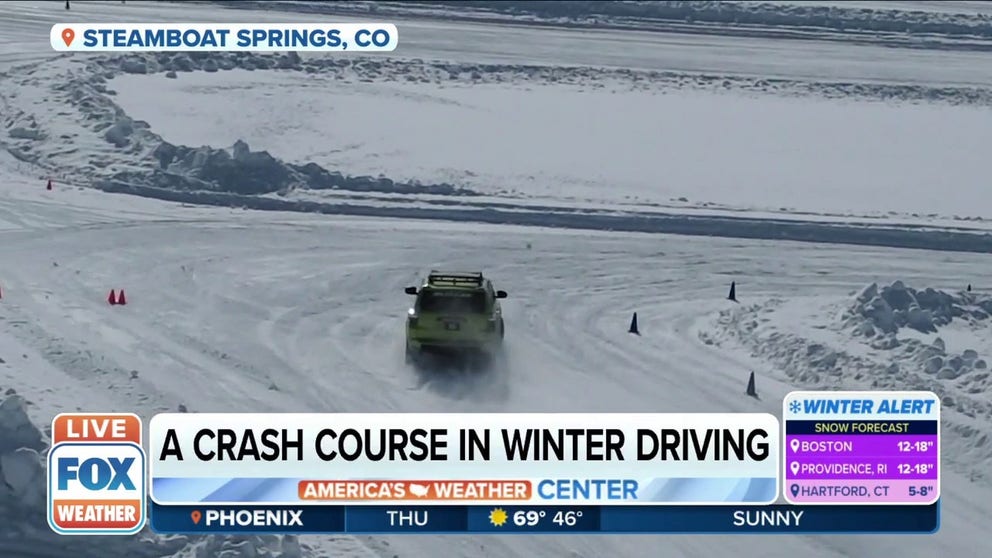Driving on the ice and driving in the snow: Weather driving tips for driving in inclement weather
Fender bender alert: Winter driving season is here and that means driving on the ice, in the snow and in inclement weather. When driving in bad weather, drivers should think about the science of slipping which may keep you safer on the snow and ice. These are ways to keep yourself safe while driving this winter.
Crash course in navigating icy road conditions without antilock brake system
FOX Weather correspondent Max Gorden is in Steamboat Springs, Colorado, where he took a crash course in winter driving.
The snow and ice of winter are here. Even those of us who are winter driving "experts" need a brush-up on the science of driving in the snow and driving on the ice. Knowing what happens when we hit the brakes and how to keep tires gripping the road can save you from towing and car repair when driving in inclement weather.
"Winter driving doesn't necessarily involve snow and ice," says Kurt Spitzner of the Bridgestone Winter Driving School and Bridgestone Winter tire test driver. Winter weather driving starts at 45 degrees Fahrenheit.

(Courtesy: WinterDrive.com)
Get winter tires when winter weather driving
"The rule of thumb from the tire manufacturers is that if you walk out the door of your house in the morning, and you can see your breath, you probably need to have winter tires on your car," reports Spitzner who says you don't necessarily need to drive in snow to need snow tires.
All-season tires are made from rubber that starts to harden around 45 degrees F. We all know how fast hard plastic sleds can go in the snow. Winter tires are designed with rubber that stays flexible down to 20 degrees below zero giving the driver more control.
While renting a car for a snowy vacation, check out the tires' ratings – look for the mountain-snowflake icon and "M+S" on the tire. And check local laws about carrying traction chains. Just because a driver doesn't pick up the car in bad weather, doesn't mean roads will stay snow free.
NOW IS THE TIME TO PREPARE YOUR VEHICLE FOR COLD WEATHER
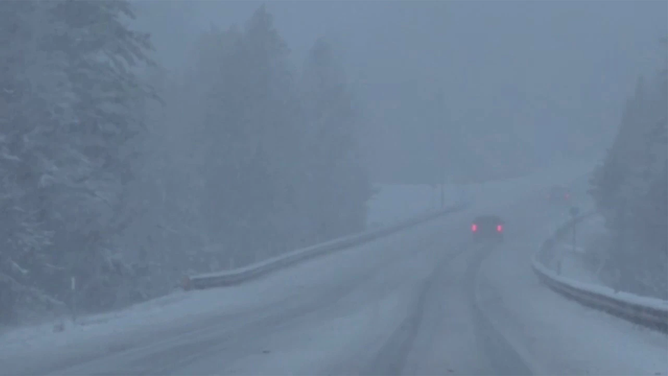
Lake-effect snow coats Champion, Michigan creating slick conditions.
(Chicago & Midwest Storm Chasers / FOX Weather)
When driving in bad weather, drivers should not rely on All-Wheel-Drive (AWD) to keep your vehicle driving safely
The school tested braking distances between four-wheel-drive and two-wheel-drive SUVs. All vehicles had winter tires.
"The two-wheel-drive SUV could actually stop shorter because it weighed less," Said Spitzner.
The added mechanics added more mass/weight to the vehicle.
He said AWD does help you accelerate, "The all-wheel-drive car will accelerate from that stoplight faster."
There is more tire gripping the road. But, it won't help you corner or stop especially in poor weather. He would drive a front-wheel-drive car in Colorado all winter if you were wondering.
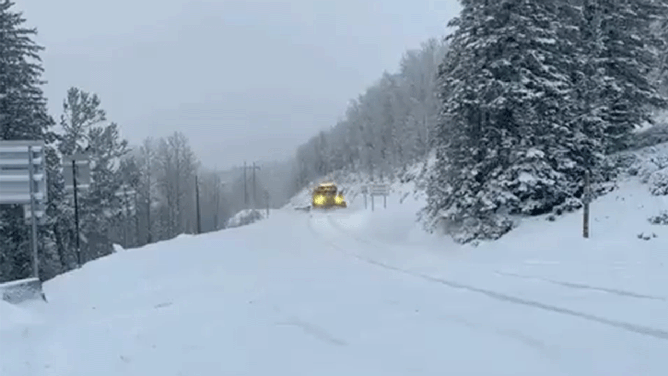
Utah Department of Transportation snowplows work to clear fresh snow on Memorial Day in the upper canyons. (Image: UDOT)
Don't rely on your car's Antilock Braking System (ABS) and traction control to keep your vehicle safely on the road while driving in the snow or driving on the ice
"Think of traction control or anti-lock brakes as thinking of yourself as a trapeze artist, and those two systems are your safety net," said Spitzner. "If you're a trapeze artist at the circus, a good trapeze artist isn't bouncing off of their safety net all the time."
He explains the science behind these two safety features on cars that are the opposite of each other. Winter weather driving depends on a driver understanding how the vehicle's bells and whistles work to arrive safely.
ABS
When you jam on your brake, the ABS senses when a tire slips and releases that brake.
"Your car is making that decision hundreds of times per second," says Spitzner. "That's what gives you that vibrating feeling on your foot when you're in a panic stop because what the ABS is doing is trying to send the most hydraulic pressure it can to whatever corner of the car has the best grip."
Traction Control
This system applies brakes to a wheel that is slipping while accelerating in the opposite way ABS releases the brake on a wheel.
Use the safety net in an emergency but try to stay on the trapeze by using the following few driving tips.
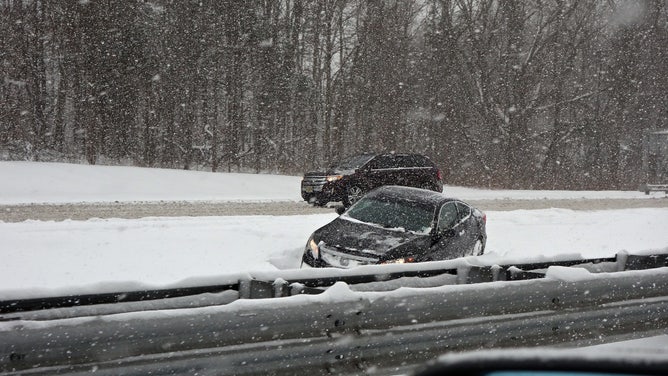
A car slipped off the highway into a ditch during a winter snowstorm near New York.
(Getty Images)
No multitasking; only ask your car to do one thing at a time when driving in inclement weather
Accelerating, braking, and turning deserve 100% effort when road conditions are less than 100% like when in the snow or poor weather.
"If you're telling the car to do two things at a time, like braking and steering, you are compromising either of those things from happening well," says Spitzner.
Brake gently, well before a turn when the car is still going straight. Once you've slowed, take your foot off the brake and turn the wheel. When the wheel is straight again, accelerate. Safe winter driving doesn't' necessarily involve complicated driving tips.
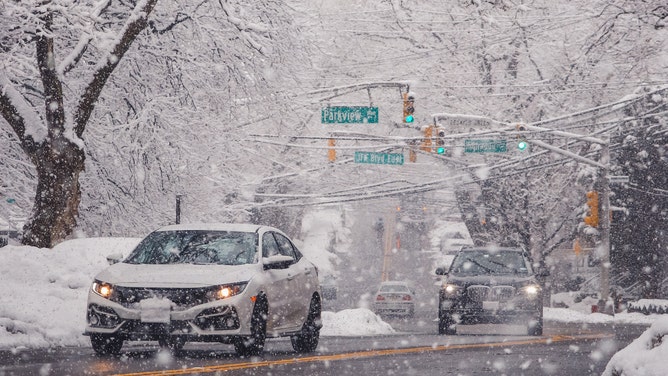
(Olga Subach / Unsplash / Getty Images)
Pre-adjust your speed, anticipate slowing-down instead of braking: When driving in bad weather, drivers should be the ultimate defensive driver
Look down the road as far as possible, so you can see turns, cars, traffic or anything else on the roadway ahead of time, so you can apply the brakes gently or downshift. Think pre-adjusting instead of reacting to turns and stops.
Sit back and look up Spitzner says, "I tell my students, if you feel yourself creeping up on the steering wheel, you know where your hands are only inches away from your face, and you're trying to peer off the edge of your hood. You're already in trouble."
This is what driving too fast in winter conditions looks like
Winter weather in Utah created some slick road conditions for drivers. The Utah Highway Patrol shared this video of a car spinning out on the road. The state saw nearly 200 accidents Thursday night.
Use your preventive measures before you get into an oversteer or understeer skid when driving in inclement weather
We have all been told to "steer into a skid" for safe winter driving. But what does that mean?
Spitzner said steering into a skid only solves oversteering. When you oversteer, the back end of the vehicle comes around.
"Most people, almost immediately, do the right thing, which is, if you were trying to turn into a right-hand turn and the back end of the car started to go out to the left, you will automatically turn the steering wheel a bit to the left to try to catch the car," he said.
Take the same right turn, but the car continues straight even though the wheel is turned. This is understeering and is much more common.
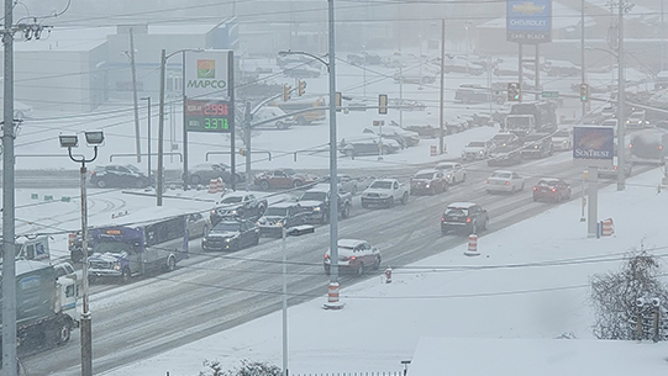
(Metro Nashville Police Department / FOX Weather)
He says, "Unfortunately, the initial response for a typical driver is to say, 'Oh, I must not have turned the wheel enough,' and they crank it more, which only makes this get worse. It makes the car plow forward."
Correcting takes practice. Take your foot off the accelerator and straighten the wheel to get the tires rolling in the same direction as the car again. Apply brakes gently.
As an instructor, Spitzner says, "While I can teach you how to get out of an understeer skid, the reality is what we need to do is teach you not to get in the skid in the first place."
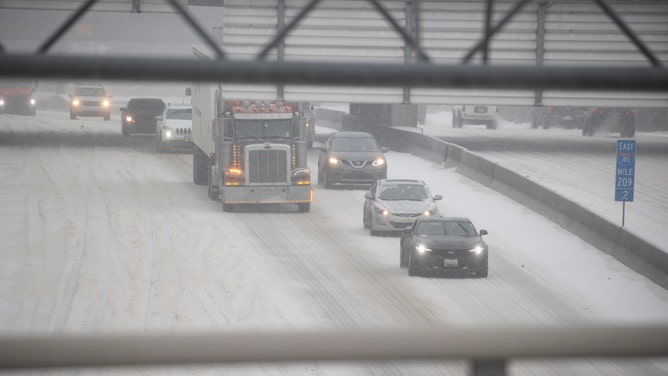
A wintery mix slows travel on interstates.
(Photo by Brett Carlsen/Getty Images / Getty Images)
Drivers downshift: Let your car slow itself down instead of braking while driving in the snow – especially nearing traffic
Let your engine slow the car down itself by downshifting to a lower speed/gear before a hill or turn.
"What it does is that you're using that lower gear as the primary means of managing your speed, and then you can just use your brakes to adjust your speed gently," says Spitzner, who recommends peeking in your owner's manual to check speed ranges for each gear.
FOX WEATHER EXPLAINS WINTER DRIVING SAFETY

(Metro Nashville Police Department)
Myths and not-so-sound-driving tips when driving on the ice
Remember when your dad told you to weigh down the car with kitty litter? We don't have to do that anymore. Spitzner says that modern cars are better balanced now.
Even pickups have the balance of most conventional cars. He says you can use the kitty litter for traction under your tires, though. Floor mats and branches also work to create more grip if you get stuck just off the road.
And he says, the driver shouldn't rock the car, alternating between forward and reverse, to rock the vehicle out of a slippery spot or ditch.
"There are a surprising number of manufacturers of automobiles now that no longer allow you to do that with an automatic transmission," he says. "Because it's a great way to blow up the transmission."
HOW TO WATCH FOX WEATHER ON TV
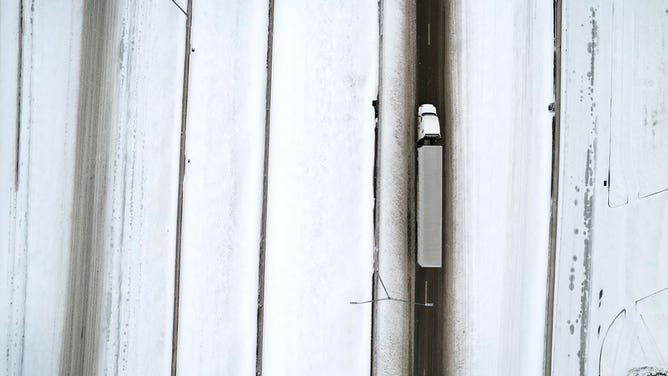
In an aerial view, light traffic moves over snow and ice on U.S. Route 183 on in Irving, Texas.
(John Moore/Getty Images)
If you slide off the road, especially in bad weather
If you think you can get safely and efficiently back on the road, try stuffing floor mats or branches under the tires – anything that will give you a little extra traction.
If you can't get yourself out quickly, call the police or roadside assistance.
"Consider your surroundings and what is safe for you. Stay warm and hydrated and a little bit fed," says Spitzner. "If you're down 25-feet in a ditch, you need to be focusing on how are you going to survive that and not how are you going to get the car back out."
TRAVELING THIS WINTER? HERE'S WHAT TO KEEP IN YOUR CAR IN CASE YOU GET STUCK.
